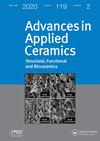高耐磨双相(Ti-Zr-Nb-Hf-Ta)C/(Ti-Zr-Nb-Hf-Ta) B2高熵陶瓷
IF 1.6
4区 材料科学
Q3 MATERIALS SCIENCE, CERAMICS
引用次数: 1
摘要
研究了细晶双相高熵(Ti0.14Zr0.2Nb0.2Hf0.2Ta0.26)C + (Ti0.38Zr0.18Nb0.22Hf0.115Ta0.105)B2在空气中干滑动的磨损特性。实验材料的密度为8.72 g/cm3, HEC和HEB晶粒尺寸较小,分别为0.95±0.30和0.99±0.27 μm。HEC和HEB晶粒的纳米硬度非常高,平均硬度分别为37.4±2.3和43.0±2.9 GPa,双体系HV1的显微硬度为29.4±2.0 GPa。在5 N和10 N作用下,摩擦系数从0.4增大到约1500 m和1000 m处分别达到0.65和0.77。在5 N载荷下,随着滑动距离的增加,比磨损率从4.75 × 10−7 mm3/Nm下降到4.2 × 10−7 mm3/Nm,在10 N载荷下,比磨损率从2.1 × 10−7 mm3/Nm下降到1.7 × 10−7 mm3/Nm。在这两种情况下,主要的磨损机制是氧化驱动的硼化物晶粒的摩擦化学反应和摩擦层的形成,以及碳化物晶粒的机械磨损。本文章由计算机程序翻译,如有差异,请以英文原文为准。
Highly wear resistant dual-phase (Ti-Zr-Nb-Hf-Ta)C/(Ti-Zr-Nb-Hf-Ta) B2 high-entropy ceramics
ABSTRACT Wear characteristics of a fine-grained dual-phase high-entropy (Ti0.14Zr0.2Nb0.2Hf0.2Ta0.26)C + (Ti0.38Zr0.18Nb0.22Hf0.115Ta0.105)B2 were investigated using the ball-on-flat technique/dry sliding in air. The experimental material showed very high density with a value of 8.72 g/cm3 and a small grain size of HEC and HEB grains with values of 0.95 ± 0.30 and 0.99 ± 0.27 μm, respectively. The nano-hardness of the HEC and HEB grains is very high with mean values of 37.4 ± 2.3 and 43.0 ± 2.9 GPa, respectively with the micro-hardness of the dual system HV1 29.4 ± 2.0 GPa. The friction coefficient values during the test with 5 and 10 N increased from a value of 0.4 and reached the values 0.65 and 0.77 at the sliding distances of approximately 1500 and 1000 m, respectively. The specific wear rate decreased with increasing sliding distance at 5 N load, from 4.75 × 10−7 mm3/Nm to 4.2 × 10−7 mm3/Nm and at 10 N from 2.1 × 10−7 to 1.7 × 10−7 mm3/Nm. The dominant wear mechanisms in both cases were an oxidation-driven tribo-chemical reaction and tribo-layer formation in boride grains and mechanical wear in carbide grains.
求助全文
通过发布文献求助,成功后即可免费获取论文全文。
去求助
来源期刊

Advances in Applied Ceramics
工程技术-材料科学:硅酸盐
CiteScore
4.40
自引率
4.50%
发文量
17
审稿时长
5.2 months
期刊介绍:
Advances in Applied Ceramics: Structural, Functional and Bioceramics provides international coverage of high-quality research on functional ceramics, engineering ceramics and bioceramics.
 求助内容:
求助内容: 应助结果提醒方式:
应助结果提醒方式:


